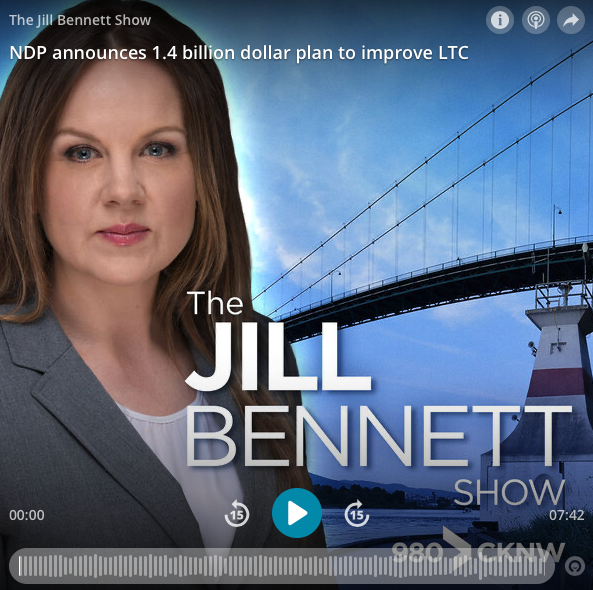BCCPA supports promise for new long-term care investments and continuation of wage leveling
The election campaign to decide who will govern in British Columbia is underway, and the respective party platforms are slowly being unveiled. Today, the BC NDP party led by John Horgan announced a platform plank focused on long-term care. BCCPA supports several components of the plan – such as a $1.4 billion ten-year commitment to replace aging long-term care homes with multi-bed wards with new buildings with single-bed rooms, and maintaining the “wage levelling” established through a provincial health order last spring.
As recently as last July, draft recommendations from BC Care Providers Association and EngAge BC included a call to decommission multi-bed wards as a pandemic “next wave” response measure, in addition to calling for the continuation of wage levelling. In B.C., approximately two-thirds of publicly funded care beds are operated by private (“for-profit”) and non-profit organizations of varying sizes. Of the other one-third of long-term care beds in our province owned and operated by the government health authorities, approximately 43% are older buildings with multi-bed wards. By contrast, non-government care homes have overwhelmingly (~85%) single-bed rooms.
Therefore, new investments to replace and upgrade B.C.’s LTC infrastructure are welcomed.
The COVID crisis hit those living in long-term care in Canada hard. Over 80 per cent of fatalities during the first wave of SARS-CoV-2 in our country happened in long-term care homes. There is no way to sugar coat the fact that our long-term care sector was unprepared for the impact of the virus.

However, political statements that imply private operators shoulder a greater responsibility for the impacts of COVID-19 in care homes are simply misleading. There are many causes for the extent of the crisis faced by long-term care since the start of the pandemic, but it is clear that the virus did not distinguish between private, non-profit and government owned sites — which were all hit hard. In Quebec, for example, government owned sites bore the brunt of COVID-19 cases. In B.C., non-profit care providers with older buildings had the largest outbreaks, with private and government-operated sites impacted as well.
During an interview on today’s Jill Bennett Show on Corus Radio station CKNW, BCCPA/EngAge BC CEO Terry Lake commented on the political “hyperbole” around private care, saying claims are simply not borne out by the evidence. “When you look at data across North America, the ownership model doesn’t correlate with the impact of COVID-19,” said Lake. “In B.C. it’s the way we deliver care here that has made the difference.”
A quote from a report from the Office of the Seniors’ Advocate would appear to back that up. It says, “in the recent province-wide satisfaction survey of all subsidized contracted and public care facilities in the province, there was no overall difference in the level of satisfaction and quality of life indicators between those facilities operated by a health authority (public) and those facilities operated by the contractors.”
At our recently concluded #BCCPA2020 virtual conference, noted academic and frequent commenter on the state of Canada’s long-term care sector Dr. Samir Sinha pointed out that Canada devotes up to 30 per cent lower than other OECD countries as a share of GDP. According to a CBC report, “As a share of GDP, Canada’s annual public spending on long-term care — approximately $24 billion — is below the average of 15 other OECD countries that report long-term care expenditures. Countries such as the Netherlands, Sweden, Denmark and Norway spend twice as much.”
“We’ve never funded the system with the same consideration that we fund the hospital sector,” says Sinha.
Sinha also points out what we were able to accomplish in our province, where the sector partners took a Team BC approach. “The standout province in Canada has been B.C.,” Sinha told Globe and Mail. “The government there acted early to protect long-term care homes and it has had far fewer outbreaks and deaths than central Canada as a result.”
This week several representatives of the Canadian Association of Long-Term Care (“CALTC”) – of which BCCPA is a proud member – have been in meetings with dozens of Canada’s Members of Parliament. Terry Lake, along with board president Aly Devji and VP Public Affairs Mike Klassen have been informing our elected representatives in Ottawa on ways our national government can play a key role in supporting long-term care. On Tuesday, CALTC released its “pre-Budget” submission outlining the need for new supports for recruitment, staff training and retention, funding for new infrastructure, and improved standards using enhanced data management tools.
BCCPA and EngAge BC’s message on long-term care to all the major political parties that hope to form government is straightforward: our success is due in part to having a mix of all care models, including for-profit, non-profit and government owned. Seniors will benefit from both public and private options, such as those offered by independent living and home health providers. Furthermore, some of the very best elder care in our province is provided by private operators in state of the art care homes. And we can all agree that British Columbia’s senior deserve the best care available in their time of need.
* * *
Today, the Canadian Medical Association Journal (CMAJ) released a revealing new paper titled “COVID-19 in long-term care homes in Ontario and British Columbia.” The paper’s authors make the following key points:
- Many more residents living in Ontario long-term care homes have died from coronavirus disease 2019 (COVID-19) than in British Columbia.
- Before the pandemic, the long-term care system in British Columbia exhibited a number of potential strengths relevant to pandemic preparedness compared with Ontario: there was better coordination between long-term care, public health and hospitals; greater funding of long-term care; more care hours for residents; fewer shared rooms; more nonprofit facility ownership; and more comprehensive inspections.
- During the first wave of the pandemic, British Columbia was faster than Ontario in responding to COVID-19, with actions to address public health support, staffing, and infection prevention and control.
- Leaders in British Columbia were more decisive, coordinated and consistent in their overall communication and response.
The CMAJ report validates that our Team BC approach is a winning strategy and one of the best defenses in the fight against the COVID threat.
More background
For additional reading on the topic of how different care models make up part of B.C.’s success story in long-term care, see the following posts:
Providing Quality Care to Seniors in residential care: Does ownership really matter?
Private sector must play key role to meet demands of our aging population




